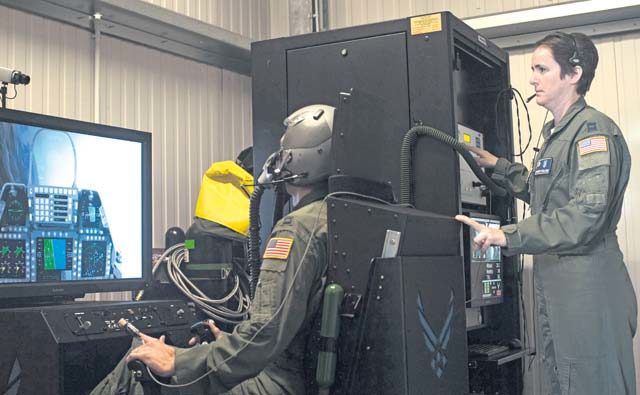
When pilots and air crews start up the engines, taxi to the runway and the take off into the horizon, they are relying on one another’s skills and expertise to get all of them back on the ground safely. The higher they soar, the more they are at risk for altitude sickness, which can manifest in a variety of ways.
The 86th Aerospace Medicine Squadron Aerospace Physiology’s primary mission is to train aircrew, pilots, loadmasters, or jumpers, and anyone else who flies on the physiological effects of altitude.
“We raise awareness of limitations in an altitude environment, because a human is the limiting factor in aviation,” said Capt. Charity Bolling, 86th AMDS Aerospace Physiology flight commander. “They say 60 to 80 percent of mishaps are human error, it’s not the machine. In order to try and prevent things from happening we need to be aware of our limitations so we can better manage things as they arise.”
Anytime someone flies above 10,000 feet they are at risk for a variety of problems such as hypoxia, which is lack of oxygen at high altitudes, spatial disorientation, loss of situational awareness, decompression sickness, trapped gas, or visual illusions. As part of a campaign to raise awareness of these issues, aerospace physiology Airmen fly with air crews at 25,000 feet to show them how to mitigate these dangerous symptoms.
“It’s to familiarize the individual with the environment they are going to be performing at so they know how their body will react, then run them through the corrective procedures,” said Master Sgt. Maria Paucar, 86th AMDS Aerospace Physiology flight chief. “What it is you are supposed to do so you are taking care of yourself and those who are flying with you.”
One of the tools the 86th AMDS Aerospace Physiology Airmen have is a reduced oxygen breathing device. When air crew personnel are hooked up to the device, the team can run a simulation catered to the crew member’s particular job while the device slowly makes them hypoxic. Aerospace physiology specialists monitor the crewmember’s vital signs and actions in the simulation and advise them on corrective procedures to take.
The device also familiarizes the Airmen with how their body reacts to a lack of oxygen, as it can manifest in a variety of ways. The experience can help the crewmember self-identify when they are feeling these symptoms when actually in the air.
“We’re not made for altitude; we’re made for being on the ground,” Bolling said. “There are all kinds of things that can lead to mishaps if we’re not aware of (the effects) or don’t know how to properly manage or try to prevent (them). That’s why it’s important, just being aware of our limitations.”
When the primary purpose of a career field is prevention, Paucar said it can be hard to see the direct results.
“If you are a doctor, you know exactly how many patients you have treated, and if you put a cast over something that’s sprained or broken it’s eventually going to get fixed,” Paucar said. “What we do is more preventative, we are doing everything we can to ensure something doesn’t happen.”
Despite the lack of clear cut results for the physiology Airmen to see, their efforts attribute to restoring readiness for the Air Force to win any fight, any time. Without the team teaching air crews how to stay safe and in control of their faculties while soaring thousands of feet above the air, there could be many more accidents, incidents, and mishaps.
“What we teach pilots and aircrews helps them stay focused on the mission while they are up in the air by increasing awareness,” Bolling said. “We give examples of mishaps explaining what occurred and why it occurred. I think it gets people thinking they better pay extra attention to this, whatever the case may be. Things can happen to experienced and inexperienced people.”
The aerospace flight broadens their basic courses to include any type of problem arriving from a variety of work environments or personal choices that can have an adverse effect on Airmen while performing their duties.
“Part of our job is to figure out what keeps people from performing at their best,” Bolling said. “Some of the things we provide training for is fatigue management, heat stress, dehydration, nutrition, pretty much all of those things about risk management.”
Pilots and other air crew personnel train extensively to ensure they are capable of performing duties and completing their missions in an efficient and safe a manner. The 86th AMDS Aerospace Physiology ensures these Airmen also know how to stay safe in the air so they can touch back down without any mishaps.
“I think aerospace physiology is one of those little gems that not a lot of people are really aware of,” Paucar said. “We’re trying to build up that whole Airman concept; making sure everybody is ready to go at any given notice. When they’re tasked to fulfill a mission they know exactly what they have to do out there and if something does happen, how they can get back home safe to their families.”


